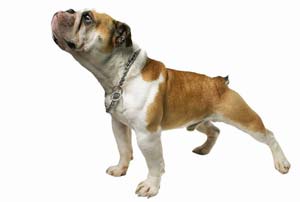
|

Types of Aggressive Dog Behavior
 |
Dog Aggression Out Of Control? Dog Training | Sit Stay Fetch™ |
Though only a small percentage of people are bitten by dogs each year, there are many other types of aggressive dog behaviors that are unacceptable. Sometimes aggressive behaviors can be obvious signs of aggression, while other types of aggressive dog behavior may be more passive. Whether you see these behaviors as a threat or more passive-aggressive, they are still behaviors that can escalate or cause problems in your home or in social settings.
Aggressive Dog Behavior is NOT Breed Specific
First, it is important to note that the types of aggressive dog behavior are not more prominent in any one breed over another. About .1 percent of dogs in every breed show signs of aggressive behavior. It is just that certain, more volatile, types of aggressive behavior in certain breeds of dogs seem to make the news more often so that we think they are more common. Therefore, it is important to realize that any dog showing signs of aggressive dog behavior needs to be trained out of those behaviors.
Signs of Aggressive Dog Behavior
There are certain types of aggressive dog behavior that occur for a variety of reasons. Most commonly, signs of outward aggression are growling, snarling, curling lips, and biting. When we discuss the types of aggressive behavior, these are the traits most people think of, because they seem to be the most threatening traits. However, common dog behaviors like mounting people, lunging, blocking your path, and barking can also be types of aggression in dogs. However, because these behaviors are not as directly aggressive toward people, dog owners tend to dismiss them as quirky traits.
Dominance Aggression
Why these types of aggressive dog behavior occur mainly depends on what the underlying causes are. There are a number of reasons for these types of behavior. One of the more common reasons for dogs jumping, lunging, blocking your path, or mounting is that the dog is trying to establish dominance. Dogs are pack animals, so they will often try to establish themselves as the alpha dog in the group. Herding dogs may even try to establish dominance over small children by "herding them" which may involve small nips at their ankles, while male dogs may try to establish dominance by trying to mount members of the family. It is important when you see these types of aggressive dog behaviors to establish that you are really the 'alpha dog' by taking control of things and situations.
Fear Aggression
Another reason for aggressive dog behavior is fear. A fearful dog's first response will usually be to put its tail between its legs, pull its ears back, and look away, or it will even run. However, if a dog feels cornered, it may lash out with growling, snarling, and even biting. It is important for your dog to feel safe, but there are many ways to condition your dog to lower a fear response.
Territorial/Possessive Aggression
This type of aggressive dog behavior may occur if your dog is feeling territorial or possessive. Dogs often have a sense of territory, even over people, and do not like to share. If they feel their territory is being breached or that family members are in danger, many of the aggressive behaviors will occur. It is important to discourage this type of behavior by taking precautions and avoiding these potentially volatile situations. For instance, if your dog is aggressive only when he or she eats, then you need to keep people away from the food bowl during feeding times. You also need to establish that you are the boss over the food.
Redirected Aggression
Especially when dogs face fear or territorial breaches, when they cannot take their aggression out on the thing causing the anxiety, they will often turn their aggression toward something or someone else. This is called redirected aggression. Again, this behavior needs to be discouraged. Be aware though that discipline may be good, but punishment is not. Using punishment to discourage the types of aggressive dog behavior will only make the problem worse by encouraging more aggression.
No matter what the reasons are behind the types of aggressive dog behavior, it is important to discourage your dog from exhibiting the behaviors. Take time to train your dog, which often requires a lot of patience and time, so that you keep your dog healthy, happy, and safe.
 |
 |
|
|